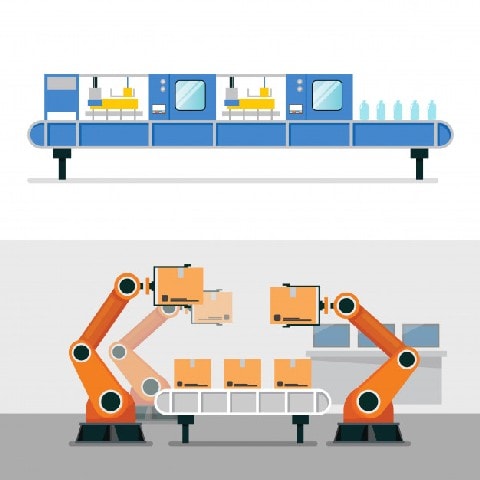People moving material and final goods from one place to another is a common sight in a company which produces some physical products. Raw material delivered from suppliers is required to take to the place where it can be used for production. Similarly, final goods are loaded in trucks to sent to their final destination. It is right to say that material handling is one of the primary activities of an organization.
Therefore, an organization must learn about the optimized methods so that maximum productivity can be attained.
Read this article to learn about material handling, its types, its objectives, and its principles.
Table of Contents
Definition of Material Handling
Material handling is an activity that involves movement of material or products within an organization from one place to another place or the flow of material or products to vehicles or from vehicles. The activities are usually confined within the boundaries of an organization. The movement of material from one organization to another is categorized as transportation work, which is not part of material handling activities.
How can companies enhance their material handling processes?
To optimize material handling, companies must consider investing in advanced technologies and automation. According to a report by Grand View Research, the global material handling equipment market size was valued at USD 25.23 billion in 2021 and is expected to grow at a compound annual growth rate (CAGR) of 6.6% from 2022 to 2030. Implementing automated solutions not only enhances efficiency but also minimizes the potential for workplace accidents, as indicated by the Bureau of Labor Statistics, which recorded a notable decrease in workplace injuries due to mechanized handling interventions.
Furthermore, businesses can utilize Warehouse Management Systems (WMS) to streamline their operations. One popular tool is Oracle’s WMS Cloud solution, which offers real-time dashboards and detailed analytics to assist in the efficient movement and storage of materials. By adopting such tools, companies can better manage inventory levels, reduce waste, and improve overall productivity, leading to significant cost savings and increased profitability.
It is not only about the movement of material. It also involves storage, protection, and control of material while it moves in different departments like a warehouse, production, and manufacturing departments. It is one of the essential tasks for organizations. A poorly handled material become waste before it can be used for production purpose or before it is sent to retail stores.
In the old times, it was mostly done manually because of the lack of technology. Because of that, the number of accidents during handling work was quite high. In present times, with the introduction of technology, almost all of the work is done using automation or semi-automation. The introduction of technology not only reduced the cases of accidents occurred but also made the work fast.
Material Handling Processes Definition:
Material handling can be defined as the science and art involved in receiving, packing, storing, and moving material in any form.
Objectives of Materials Handling Processes
Material handling is one of the most critical activities taking place in an organization. Material handling makes a large portion of the total business expense of a company.
Therefore, achieving the lowest cost and maximum production can be considered as the main objectives of the material handling process.
1. Reduced cost using a material handling
The first and foremost objective of material handling is lowering the cost of production. Because a large portion of the total production cost is spent on material procurement, storage, and movement. Material is crucial for the production process.
The process of production will halt if the material is not provided in sufficient quantity and on time. Therefore, material handling is given the utmost importance. Companies always look for methods that can be used for the optimized use of material.
By the use of sophisticated methods, the cost of production can be reduced to a significant amount.
2. Reduced waste of material
Another significant concern of an organization is to minimize material waste. Sometimes, the material gets wasted because of poor storage, or sometimes it gets wasted while moving it from one place to another.
An appropriate material handling not only concerns about the movement of material but also takes care of placing orders of the right amount, making the use of the material at the right time, keeping the right amount of inventory, and moving material using better techniques and with caution.
All of this is taken care of to reduce the wastage of material. Moreover, lower wastage for material results in lower costs. As a result of which the profit margin of the organization will increase.
3. Improved work condition
Before the inclusion of technology, all movement and storage works were done manually. Some labors were responsible for performing these tasks. They were responsible for all the loading and unloading work.
Poor results in frequent accidents on-site because of poor work conditions. A proper and well-thought material handling also takes care of people performing the work.
4. Enhanced distribution
Distribution means the delivery of final goods to the retailers and wholesalers. A lot of material gets damaged during transportation because of poor packing and poor storage.
It helps in the reduction of damage to products during shipping and handling. In addition to this, it also concerns the storage location of the material. A proper storage location reduced the chances of material gets damaged in the storage house.
5. Optimized warehouse capacity
Warehouse cost also adds to the price of the final product. Warehouse capacity means the ability for storing goods. It is essential to take care of the layout of the warehouse, flooring of the warehouse, and aisle space in the warehouse to have optimized warehouse capacity.
Optimized warehouse capacity also helps in reducing the overall production cost.
6. Improved flow of material
A smooth flow of material is when material enters the company in raw material form at the time when it is required and exits the organization in the form of final goods. The flow of material gets disturbed when the material is not available when it is needed for the production or gets damaged rather than being used for the production process.
It concerns with the smooth flow of material in the organization. It improves the circulation of material in the organization as a result of which material stays for less time in the warehouse and is used for production at earliest.
7. Full equipment utilization
Expensive machinery and equipment are used for the production process. These equipment fails to perform at their maximum capacity because of poor material handling.
Because the performance of these equipment depends mainly on the speed at which the material is supplied and received. Therefore, material handling also helps in the full utilization of the capacity of the equipment.
8. Workers’ safety
The last but not least objective is the safety of workers. Poor material handling can result in accidents in the factory, which are very risky for workers working there.
Principle
The material handling methods are designed based on the principles that you are going to learn in this section. The followings are the principles:
- Cost principle: To encourage minimum expenditure while materials handling.
- Computerization principle: To encourage maximum use of computers and automation as materials.
- Energy principle: This principle is concerns about the consumption of energy.
- Ergonomic Principle: To identify the human limitations and capabilities to do the work.
- Ecology principle: To ensure the least impact on the ecological system because of material handling work.
- Flexibility Principle: To encourage the use of tools and methods which can be used in different types of work conditions.
- Gravity Principle: To promote the consideration of gravity principle in materials handling.
- Layout Principle: The layout principle is concerned with the sequential order of material handling operations.
- Maintenance principle: The maintenance principle is for regular maintenance and repair of machinery and device in materials handling.
- Mechanization principle: Mechanization principle is concerned with the deployment of mechanization methods to speed up the work and reduce the efforts of humans.
- Orientation principle: To study the existing processes and problems before getting into preliminary planning.
- Planning principles: To plan by including basic requirements and alternative approaches in materials handling.
- Standardization principle: The standardization principle encourages the standardization of tools and techniques.
- Simplification principle: The simplification principle is concerned with making the process of material handling as simple as possible.
- Space utilization principle: The space utilization principle encourages the optimized use of available space.
- Systems Principle: The system principle is concerned with material and storage activities in materials handling.
- System flow principle: The system flow principle is concerned with the integration of physical material flow with the data flow.
- Safety principle: The safety principle is concerned with the rules and regulations related to the safety of workers working in materials handling.
Importance
It is essential because a large portion of the manufacturing cost is made of material handling costs. The cost of production can be reduced to an exceptional level with the help of proper handling.
Moreover, the material is needed to move to several places before it is converted into final goods. Therefore, the lack of appropriate handling can result in the damage of products before they can be converted into final products. The cost of damaged goods also adds to the manufacturing costs, and as a result, the overall profit of the organization reduces.
If I talk about the importance of material handling from the safety of workers working in the organization and the safety of machines and equipment used for the production process, then it has a significant role to play. Workers are responsible for loading and moving material across the organization.
Poor material handling can result in accidents during this process and due to accidents not only the material will get damaged but the risk to the life of workers also increases. Therefore, it is necessary for the sake of workers working in the organization as well as to minimize production costs.
Types

The types of material handling have changed because of the enhancement of technology. In this section, I will discuss all kinds of material handling that are used in the companies to receive, store, and move material in the organization.
Let us learn about different types of material handling in the chronological order of their introduction in industries.
1. Manual material handling
The first method is used for material movement is manual material handling. In this type of handling, the whole work of the movement is dependent on the workers. The workers lift, carry, deliver, empty the container of material by their hands. This type of material handling is a prolonged method for material movement as a result of which it causes a delay in the production work and stops efficient machines to deliver up to their full capacity.
Manual handling not only slows down the production work but is also hazardous for workers who do the work. They do a lot of physical labor, which affects their health. The shoulders and lower back of workers get strained which affects not only their work capacity but also the overall work capacity of the organization. Moreover, they are also prone to accidents because of doing a lot of physical work.
Sometimes, workers get seriously injured in the accidents and left with life long injuries. This is not good for the workers as they become incapable of earning their bread and butter, and it puts an extra financial burden on the company too.
2. Semi-automated material handling:
The semi-automated material handling is when workers do the work of material handling with the help of machinery and other carrying trollies and trams. Semi-automation becomes popular in industry in the initial days of the introduction of technology. It is a good alternative for manual handling. Semi-automation not only reduced the physical work of workers but also speed up the production work.
In semi-automation handling, workers do the work of loading and unloading themselves but rather than carrying material on their backs or by holding in hands; they can move the material using trollies or trams.
It is economical for a company as a company hires a smaller number of workers to do the same amount of work. Moreover, it also lowers the rate of mishappenings in the organization as a result of which the medical expenses of the organizations also reduce.
3. Automated material handling:
The next type is automated material handling. Automated handling reduces or eliminates manual work. Automated handling means machines and robots perform work. Robots have replaced the manual work completely. In developed countries like Japan, most industries have replaced their workforce with worker robots.
There are several advantages to automated handling. The first benefit is that it increases the speed of production work. Robots work 100 times faster than a human worker. Moreover, Automation also reduces the chances of accidents during work. Workers are not required to do physical work in the gruesome work conditions. They can sit comfortably and can control robots do all the physical work.
Automation also reduces the production cost for the company. Rather than hiring many workers, companies can employ a few workers who can control the robots. This reduces the expenses of workers’ wages and medical expenses.
For example, Amazon is replacing its fulfillment center jobs with robots. Fulfillment centers were employing a considerable number of employees. Now, at the place of humans, robots will pack orders to send out for delivery.
Liked this post? Check out the complete series on Distribution



Thank you for the help and knowledge you have provided!
Nice content